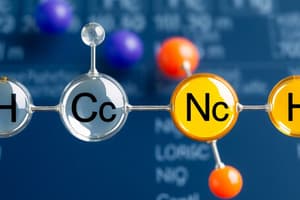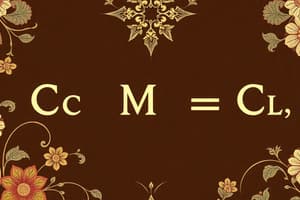Podcast
Questions and Answers
In chemical nomenclature, what is the first question to consider when naming a compound?
In chemical nomenclature, what is the first question to consider when naming a compound?
- Does the compound contain carbon?
- Is the compound organic or inorganic?
- What is the molar mass of the compound?
- Is the compound ionic or covalent? (correct)
According to nomenclature rules, what type of compound uses Greek prefixes to indicate the number of atoms of each element?
According to nomenclature rules, what type of compound uses Greek prefixes to indicate the number of atoms of each element?
- Ionic compounds with polyatomic ions
- Simple covalent molecules (correct)
- Acids formed from nonmetal oxides
- Hydrated ionic compounds
What principle is applied when naming ionic compounds?
What principle is applied when naming ionic compounds?
- The principle of electron pairing
- The principle of charge neutrality (correct)
- The principle of maximum covalency
- The principle of minimum energy
When naming monatomic anions, what suffix is added to the elemental name?
When naming monatomic anions, what suffix is added to the elemental name?
How are the charges of Type II metal cations indicated in the names of ionic compounds?
How are the charges of Type II metal cations indicated in the names of ionic compounds?
What is the correct formula for the ionic compound formed between aluminum and oxygen?
What is the correct formula for the ionic compound formed between aluminum and oxygen?
Which of the following is the correct name for the compound $FeCl_3$?
Which of the following is the correct name for the compound $FeCl_3$?
What is the name of the polyatomic anion $SO_4^{2-}$?
What is the name of the polyatomic anion $SO_4^{2-}$?
Which of the following acids is named correctly, based on the rules of nomenclature?
Which of the following acids is named correctly, based on the rules of nomenclature?
What is the correct name for $N_2O_5$, according to the rules for naming simple molecules?
What is the correct name for $N_2O_5$, according to the rules for naming simple molecules?
What is the formula for hydrosulfuric acid?
What is the formula for hydrosulfuric acid?
According to the nomenclature rules, which name is correct for $CuCl$?
According to the nomenclature rules, which name is correct for $CuCl$?
Which of the following statements correctly describes the naming of acids?
Which of the following statements correctly describes the naming of acids?
Which of the following is the correct formula for lead(IV) oxide?
Which of the following is the correct formula for lead(IV) oxide?
Which of the following compounds contains a polyatomic ion?
Which of the following compounds contains a polyatomic ion?
Flashcards
What is Nomenclature?
What is Nomenclature?
The naming of chemical compounds.
What are Binary Ionic Compounds?
What are Binary Ionic Compounds?
Compounds formed between a metal and nonmetal, named by stating the cation (metal) first, then the anion (nonmetal) with an '-ide' suffix.
What are Type II Cations?
What are Type II Cations?
Metals that can form multiple stable cations with different charges.
How to Name Type II?
How to Name Type II?
Signup and view all the flashcards
What are Polyatomic Ions?
What are Polyatomic Ions?
Signup and view all the flashcards
What are Oxyanions?
What are Oxyanions?
Signup and view all the flashcards
What are Covalent Compounds?
What are Covalent Compounds?
Signup and view all the flashcards
What are Greek Prefixes in Nomenclature?
What are Greek Prefixes in Nomenclature?
Signup and view all the flashcards
What is the order for naming?
What is the order for naming?
Signup and view all the flashcards
What is an Acid?
What is an Acid?
Signup and view all the flashcards
How do you name a binary acid?
How do you name a binary acid?
Signup and view all the flashcards
How do you rename oxyacids
How do you rename oxyacids
Signup and view all the flashcards
Study Notes
- Nomenclature, the naming of chemical compounds, is critical in chemistry because chemicals can have multiple names or different chemicals can share the same name.
- The nomenclature rules depend on the types of bonds in the compound being named.
Nomenclature Strategy Overview
- The first question to ask is whether the compound is ionic or covalent
- Covalent compounds, typically between two or more nonmetals, require determining if it's a simple molecule or an acid
- Simple molecules use Greek prefixes to indicate the number of atoms of each element.
- Acids are named based on the ionic compound they would form if hydrogen were a cation.
- Hydrogen always forms a covalent bond and can't lose its only electron to be a cation due to high charge density.
- Ionic compounds are named using the principle of charge neutrality.
Ionic Compounds
- When naming ions:
- Cations use the metal's elemental name followed by "ion" or "cation".
- Nonmetal anions use the elemental name with an "-ide" ending.
- For example, sodium (Na) becomes the sodium ion or sodium cation (Na+).
- Chloride (Cl), from Cl₂, is called chloride (Cl-).
- Using "chloride anion" or "chloride ion" is redundant.
- Ionic compounds have positive cations and negative anions
- Their chemical formula must be neutral per the Principle of Charge Neutrality.
- State the cations and anions without indicating the numbers with using charges.
- The formula is based on the lowest whole number ratio of ions for a neutral formula.
Binary Ionic Compounds
- Binary ionic compounds contain a metal and nonmetal and follow simple rules:
- Name the cation first.
- Name the anion second, with an "-ide" suffix.
Monatomic Cations
- There are two types of monatomic cations:
- Metals forming only one charge state (Type 1)
- Metals forming multiple charge states (Type 2).
- Monatomic anions only form one charge state.
Type 1 and 2 Cations
- For simplicity, metal cations are either Type 1 (invariant charge) or Type 2 (variable charge).
- Metals lose electrons to form cations, and nonmetals gain electrons to form anions.
- Anions gain enough electrons to fill their valence shell, becoming isoelectronic with the nearest noble gas.
- Metals in groups 1A & 1B tend to form [+1] ions
- Metals in groups IIA & IIB tend to form [+2] ions
- Metals in groups IIIA & IIIB tend to form [+3] ions.
- To determine a formula, name the metal, then the nonmetal with an "-ide" ending.
Type II Cations
- Most transition metals can form multiple stable cations, use Roman numerals in parentheses after the metal's name to indicate its charge, e.g., iron(II) for Fe+2 and iron(III) for Fe+3.
- Some common metal ions have Latin names
- Iron(III)= ferric
- Iron(II)= ferrous
- Tin(IV)= stannic
- Tin(II)= stannous
- Copper(II) = cupric
- Copper(I) = cuprous
- Lead(IV) = plumbic
- Lead(II) = plumbous
- Mercury(II) = mercuric
- mercury(I)= mercurous
- The "-ous" ending is for the lower oxidation state
- The "-ic" ending indicates the higher oxidation state
Mercury
- The mercury(I) ion is a diatomic cation (Hg2+2).
Polyatomic Ions
- Polyatomic ions are covalent units (molecules) where the number of protons does not equal the number of electrons.
- Polyatomic ions end with -ide, -ate, and -ite.
- Oxyanions consist nonmetals bonded to oxygen
- Carboxylate ions constitute another type of polyatomic ion
- Ionic compounds like ammonium acetate consist entirely of nonmetals but form a crystal structure of cations and anions.
Naming Oxyanions
- Oxygen atoms are attached to a nonmetal, and the nonmetals are from the same periodic group from homologous oxyanions.
- "-ate" ions have more oxygens, and "-ites" have less.
- "per_ate" has the most
- "hypo_ite" has the least.
Covalent Compounds
- Molecules are compounds held together by covalent bonds.
- There are two types of covalent compounds: classical molecules and acids.
- Hydrogen forms acids because it cannot lose its electron to become an ion, but can form a polar covalent bond
- Classical molecules arise when nonmetals form covalent bonds with each other
- In molecules, the formula represents the chemical entity, not the lowest ratio of ions
- Molecules like P₂O₅ and P₄O₁₀ have the same phosphorus to oxygen ratio but are different molecules.
- To name atoms a Greek prefix indicates the number of atoms in the formula.
- The prefix "mono" is often omitted if there is only one atom.
- Place the more "metallic" atom first (further to the left on the periodic table)
- If there is a central atom, place it first, followed by the atoms attached.
Acids
- In binary ionic compounds, an alkali metal typically loses an electron to form a (+1) cation while the nonmetal forma an anion.
- The resulting cation has core (inner shell) electrons, resulting in a stable ion, even if the net charge is positive.
- Hydrogen is also in group IA but has not inner shell electrons, so it can't from a cation - that would be a subatomic particle
- Acids based on the nomenclature of ionic compound acids:
- -ide becomes hydro[anion stem]ic acid
- -ite becomes [anion stem]ous acid
- -ate becomes [anion stem]ic acid
- Compounds that release H+ in water are acids in aqueous or (aq) form are acids
- If salt is binary, it forms binary acids;If salt has oxyanions it forms oxyacids with endings
Studying That Suits You
Use AI to generate personalized quizzes and flashcards to suit your learning preferences.



